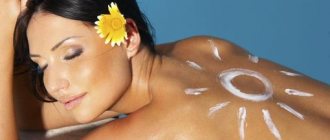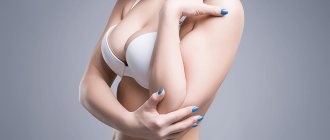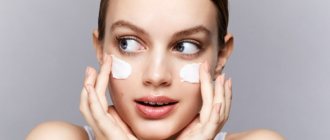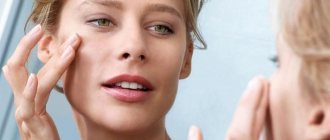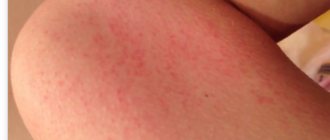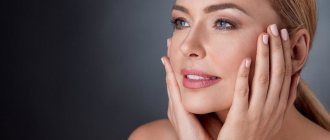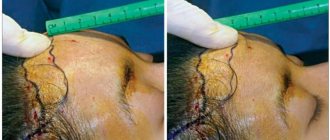I phototype
Name:
Celtic, Scandinavian.
Leather:
very light, sometimes translucent, milky white or with a porcelain tint, easily blushing when nervous; Often with a lot of freckles. This skin type is typical for Europeans.
Hair:
almost always very light or red.
Eyes:
blue, gray or green.
Reaction to ultraviolet light:
highest possible photosensitivity. Since the pigment is formed in small quantities, after just a quarter of an hour of exposure to direct sunlight or visiting a solarium without special sunscreen, signs of a first-degree burn (hyperemia and burning) may appear. Subsequently, peeling occurs, and residual hyperpigmentation may persist for a long time. An even tan is almost unattainable.
Recommendations:
Since this phototype has the highest risk of developing skin cancer and melanoma, it is advisable to avoid exposure to sunlight. If sun exposure is necessary, it is mandatory to use photoprotective products with a high protection factor (SPF from 30 to 50).
How to determine your phototype
The most popular tool for determining your phototype is the Fitzpatrick scale.
, providing 6 skin types. It is based on how the skin reacts to the sun's rays affecting it. It is on this basis that we can formulate the basic rules for tanning according to skin type.
- 1 phototype
– Celtic. The skin of these people is porcelain-colored, its structure is delicate and capricious, often freckled. Most often these are natural blondes or redheads. The level of pigmentation is quite low, so the skin does not tan. If you still dare to sunbathe, then you will need to choose protective products for sensitive skin and with the highest level of SPF filter. - Phototype 2
– Aryan, also called Nordic. External signs are: ivory skin, warm yellowish tint, freckles are rare. They can also be classified by light-colored eyes and light brown hair. This type of skin does not tan for a very long time; it is possible to get only a light shade. The possibility of a burn is only in the first days, then the skin gets used to it, so you need to start sunbathing for 3-5 minutes, no more. - Phototype 3
– dark European. These are the happy owners of dark skin with warm shades. Eyes are most often brown, hair is chestnut or dark brown. They tan very easily, the tan is beautiful and even. It is preferable to start on the first day with 20-minute sunbathing. - Phototype 4
– Southern European (also called Mediterranean). Dark skin with a bronze hue. Both eyes and hair are dark. This type of skin never burns. This is the result that is usually achieved by procedures in a solarium. - Phototype 5
– Middle Eastern (in some sources – Indonesian). He is characterized by very dark skin that is not susceptible to sunburn, and dark hair that does not fade in the sun. Protective products should be selected directly labeled “for dark skin” to eliminate the possibility of photoaging. - Phototype 6
– African (Australian aborigines are also included in this group). Distinctive features include deep chocolate brown skin combined with thick, coarse black hair. The eyes are also black. Sunburn is impossible for this phototype, but you need to be careful when epilating (especially IPL + RF), as there is a danger of hyperpigmentation.
Note!
Tanning (in a solarium or in the open sun) should always be planned in advance and seriously prepared, with the duration of the session calculated, in order to eliminate the possibility of thermal burns. The procedure time should be calculated based on the skin's reaction to ultraviolet radiation.
It is also necessary to remember that the effect of ultraviolet radiation on the skin should be dosed, especially as the body grows older. The fact is that over the years the risk of skin cancer increases (melanoma, as well as squamous cell or basal carcinoma). Those who belong to phototypes 1 and 2 should be especially careful.
What will knowing your skin phototype give you?
It is useful for every person to understand their skin phototype, as this information will help prolong its youth and freshness.
It is important for professionals to know how many skin phototypes there are and to be able to identify them, because the correct prescription of light-thermal treatment (laser and photoepilation) depends on this.
Knowing your level of sensitivity to UV rays will help you prevent the appearance of age spots and choose cosmetic sun protection products.
According to statistical studies on skin health, ultraviolet radiation can contribute to the appearance of skin tumors.
You need to know your skin phototype for:
- correct selection of protective cosmetics with the required SPF level;
- determining the safe mode and duration of exposure to ultraviolet radiation (including artificial) to prevent burns;
- correct selection and favorable completion of cosmetic procedures (chemical or laser peelings);
- slowing down the processes of skin photoaging;
- reducing the risk of developing skin cancer.
It is very important to know your skin phototype, since thanks to such information you can provide high-quality protection and care, and choose the right cosmetics and cosmetic procedures. Accordingly, this information will be useful when choosing a modern device for light hair removal.
Read material on the topic: How to care for facial skin: home care and salon treatments
Pigmentation disorders and methods of their correction for various skin phototypes according to Fitzpatrick
Principle of action, indications and features of gas-liquid peeling of facial skin
Pigmentation disorders may appear on the skin depending on its Fitzpatrick phototype. Thus, on fair skin (phototypes I–IV), freckles may appear, which increase over time under the influence of ultraviolet radiation and visually age the face.
Dr. Townshend notes that patients with skin types IV-VI often do not use sunscreen, as a result of which they experience dyschromia - the appearance of light or dark spots on the skin.
Preparing the skin for correction of pigmentation disorders depending on the phototype
Before starting any procedure, the patient's skin must be properly prepared.
It is important to ensure that the treatment plan chosen will not cause further damage to the skin.
Esthetician Rita Racus uses the Visia system to scan the skin and assess its condition at the level of different layers. After this, the training course is selected depending on the depth of the damage, for example:
- vitamin A (concentration is selected depending on the degree of damage);
- hydroquinone, retinol and treninoin;
- procedures on fair skin are sometimes carried out without special preparation, but in this case the results are less pronounced.
To correct pigmentation disorders, the following are most often used:
- laser and IPL therapy;
- chemical peels;
- preparations based on hydroquinone.
Features of skin protection from the sun for different phototypes
The sun protection factor (SPF) describes the approximate amount of time a person can be exposed to the sun without risk.
For example, if we can expose our skin to the sun for 10 minutes without burning, a factor of 15 will protect it for 2 and a half hours: 15 X 10 minutes = 150 minutes. With SPF 30 we would be protected (30 x 10 minutes) for 5 hours.
However, experts recommend reapplying sunscreen every two hours and after contact with water.
Knowing your skin phototype is very important to understanding how our skin reacts to sun exposure and how we should protect it. Because proper protection guarantees healthy and beautiful skin.
- Celtic type.
People with the Celtic skin phototype practically do not produce melanin. Because of this, when exposed to ultraviolet light for a long time or during cosmetic procedures, redness, burns, itching, burning, and blisters appear on the skin.People with such photosensitivity are recommended to stay in direct sunlight for no more than 10 minutes, while using sunscreen with SPF 40-60 for the face and SPF 20-40 for the body.
- Nordic type.
With this skin phototype you can sometimes sunbathe, but the tan goes on poorly and slowly, in addition, burns often appear. With the right selection of tanning cosmetics, you can get an even bronze shade.The permissible time spent in direct sunlight is no more than 20 minutes.
Before tanning, you need to treat your skin with sunscreen with a protection factor of 20–40 for the face and 10–20 for the body.
- European type.
People with the third skin phototype can be exposed to direct sunlight for up to 30 minutes and not be afraid of burns, since their skin tolerates the effects of ultraviolet radiation well. To protect the body, you should use a cream with an SPF factor of 10–15, and for the face – 10–20. - Mediterranean type.
For representatives of Mediterranean skin type, getting a beautiful, even tan is not difficult. Their skin tans quickly and evenly and remains dark for a long time.It is recommended to stay in direct sunlight for no more than 40 minutes.
To protect your skin from ultraviolet rays, you should use a cream with an SPF factor of 10–20.
- Middle Eastern and African American types.
The fifth and sixth skin phototypes allow their owners to stay in the sun for a long time without consequences.The use of sunscreen cosmetics is not required.
Regardless of the rules recommended for each type of photosensitivity individually, it is necessary to follow the general instructions for tanning:
- Avoid being in the sun from 11:00 to 16:00.
- Use sunscreen every time you tan.
- Be sure to drink water.
- Cover moles from direct sunlight.
- Wear a hat and glasses for sun protection.
Real professionals at the Veronika Herba beauty and health center, which is equipped with effective and modern equipment, will help you determine your skin phototype.
- This is a beauty center where you can take care of yourself at a reasonable cost, while your face and/or body will be treated not by an ordinary cosmetologist, but by one of the best dermatologists in Moscow. This is a completely different, higher level of service!
- You can receive qualified help at any time convenient for you. The beauty center is open from 9:00 to 21:00, seven days a week. The main thing is to agree with your doctor in advance on the date and time of your appointment.
Sign up for a specialist consultation by calling 8 (495) 995-15-13
, and you will see for yourself!
IV phototype
Titles:
Mediterranean, South European.
Leather:
dark, olive, no freckles. The phototype is typical for residents of Latin America, Asia, the Caucasus and the Mediterranean.
Hair:
dark chestnut or black.
Eyes:
brown, dark brown or black.
Reaction to ultraviolet light:
the skin has high natural protection (about 40 minutes). A pronounced and lasting tan appears quickly. Sunburn is very rare, but prolonged exposure to high doses of ultraviolet radiation can cause photoaging of the skin.
Recommendations:
the use of light protective agents (SPF from 8 to 20) to prevent solar aging.
Practical significance of phototypes
It is advisable for every person to find out their skin phototype, since this has a direct bearing not only on external beauty, but also on health. For example, it is considered statistically significant that the development of certain types of skin tumors is directly related to the level of ultraviolet radiation absorbed by the dermis.
- determine a safe regime for staying in the sun or in a solarium, which will result in an even and lasting tan and no burns;
- choose the right products with a sufficient level of sun protection index SPF (Sun Protection Factor);
- undergo cosmetic procedures associated with dosed damage to the skin (chemical or laser peeling) without complications;
- avoid skin photoaging;
- significantly reduce the risk of oncodermatological diseases.

